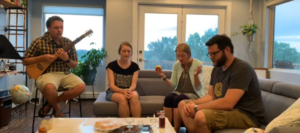
Lucas Cranach the Elder, The Reformers Luther and Hus Giving Communion to the Princes of the House of Saxony, 1472-1553, woodcut, National Gallery of Art, Washington D.C., https://www.nga.gov/collection/art-object-page.43174.html
“Eat the livestream, all of you.”
In the 15th and 16th centuries, two reformers, Jan Hus and Martin Luther, set out to remedy a problem: the laity were not receiving wine in Communion. They balked at the disregard for Christ’s command, “drink from it, all of you” (Matt 26:27) which Luther and Hus took to mean both the clergy and the laity. The church has revisited this definition of “all of you” many times in its history, opening the table wider to include more of the faithful. Today in this emerging era of digital worship, we wonder how “all of you” might include those who join on smartphones, TVs, and VR headsets.
For some Lutherans, this has been controversial, especially since the onset of the Covid-19 pandemic. In the Evangelical Lutheran Church in America, the largest denomination of Lutheranism in the US, we wondered whether to celebrate Communion in digitally mediated ways while everyone was stuck at home.[1] Some scholars and leaders dismissed the practice as shallow and consumeristic. [2] Yet, amidst controversy, Lutheran congregations throughout the United States found ways to celebrate the meal together. Now as congregations return to in-person worship, many of these worship services have become hybrid services (simultaneously gathering people in buildings and online). Congregations have an opportunity to set tables wide enough and adaptable enough to include the whole hybrid assembly in Communion.
Throughout these last two years of presiding over the hybrid table in my own ministry contexts, I have come to believe Holy Communion is vital to hybrid worship, not just for those who worship on an iPhone, but for the very worshipers who bring their bodies to church each Sunday. In this project I set out to root hybrid Communion in the Lutheran theological tradition and create helpful steps for congregations to make their tables wider than we ever imagined possible.
What is Hybrid Communion?
Hybrid Communion is Communion! It is the meal where we meet Jesus. In bread and wine, and with Christ’s promise, the Holy Spirit unites us with Jesus. It is a sacred gift that is meant to be shared with all of God’s people. It becomes hybrid when the meal is celebrated by an assembly of people who are gathered simultaneously through different modes. The tables may look different, but the meal is the same.
Jesus is really here.
When we receive Communion, we receive the real presence of Christ. This is great news for the hybrid assembly and especially for people who worship in places that don’t always feel sacred. At home, Communion transforms our coffee tables into altars, our kitchens into sacristies, and our living spaces into sanctuaries. Digitally mediated worship services are often called “virtual.” But there is nothing virtual about Holy Communion! It is the event of Christ’s body showing up in a real way in our lives.

Worshipers gather around a coffee table for Holy Communion. (As a part of a worship service at St John Lutheran Church in Dickinson, ND on August 13, 2020) https://www.facebook.com/watch/live/?ref=watch_permalink&v=307435243827358
You can taste the promise.
In Communion, Christ comes to us in something we can touch, taste, and smell. So much of our online worship experiences are limited to our eyes and ears. But in Communion, Christ comes in contact with our bodies. Luther once said,
“There is no more intimate, deep, and indivisible union than the union of the food with him who is fed. For the food enters into and is assimilated by his very nature, and becomes one substance with the person who is fed…. Thus in the sacrament we too become united with Christ, and are made one body with all the Saints.” [3]
When the hybrid assembly gathers around the hybrid table, we get a fully embodied experience of the Lord. For people who criticize digital worship experiences as being disembodied (even though nothing a human body does is every disembodied), hybrid Communion engages the whole body in the experience of worship.
This meal does not happen in isolation. Sure, when you sup at the Lord’s table you have a very personal encounter with the risen Lord. But that’s not all! By taking the body of Christ into your body, you become one with the whole body of the saints. Just as Paul promised, “Because there is one bread, we who are many are one body, for we all partake of the one bread” (1 Cor 10:16-17).
Communion is about community. When we gather at the table we share that table with our neighbors and we become united with them, sharing their joys and their burdens. In hybrid Communion we are united with those we see in the pews and those we cannot see who worship with us in non-traditional ways.
Setting the Hybrid Table
If your congregation is ready to introduce hybrid Communion practices or wants to rethink what you are already doing, here are some helpful action steps to take:
First step: educate
We can no longer assume that those who are new to the table are children. Churches have to recognize that there are many novices at the table who have little or no experience with the theology and practice of Communion.
- Have regular first communion classes on Zoom. In these classes, touch on the major theological themes of Communion listed above: Jesus is here; Christ gives us something to hold onto; we are united with the whole fellowship of the saints.
- Create on-demand resources for visitors to better understand the history, theology, and practice of Holy Communion. These can be simple sheets or short videos posted prominently on your website or socials.
- Make your liturgies more educational. This is good advice for any church in a post-Christendom context because we cannot assume people know what Jesus promised for us at his table.
Second step: eliminate stumbling blocks
A big conversation topic around digital Communion is access. Can everyone gather at this table?
- If people lack the materials, help them! For people who are worshiping locally, send volunteers with bread and wine. For folks far away, use an app like Drizly to deliver the wine.
- Host theological baking classes on Zoom, where you can make bread and learn some of the history and theology of this important meal.
- Use accessible and intuitive platforms like your church website, Facebook, or YouTube.
- Enhance the audiovisual quality of your livestream. Remember, many will access with phones or tablets with small speakers. Audio quality is paramount to helping people hear the Word.
- If people lack internet access, become an advocate for internet access in your community.
Third step: create more welcoming liturgies.
Our liturgies are the work of the people, which includes the whole hybrid assembly. How can our liturgies welcome, honor, and include those who worship online?
There are two significant moments in our liturgy that point the whole hybrid assembly to the Lord’s Supper. First, is the Invitation to Communion. This is the moment in the liturgy when presiding ministers invite the congregation to eat the sermon. At the table all of Christ’s promises become specifically located for the worshiper. Second, is the distribution. How can your church’s distribution practices call attention to everyone who is gathered at the table?
Some ideas for hybrid distribution:
- Have households distribute the meal to each other and give them the language to use.
- Speak the words of distribution directly for those who are the sole worshiper in their setting. Look at the camera and say “this is the body of Christ given for you.”
- Have pictures or names of digital worshipers published for the whole congregation to see, so we know who is gathered at the table.
- Set up a way for digital worshipers to speak the words of distribution to in-person worshipers as they receive the elements. You could place a tablet on a stand behind the wine.
However you set your hybrid table, you can trust that Christ will be present uniting the whole body of Christ, showing up in our lives, and giving us the gift of his forgiveness, grace, and life!
[1] ELCA Worship Staff, “Worship in Times of Public Health Concerns: Covid-19/Coronavirus,” Evangelical Lutheran Church in America, March 20, 2020, https://download.elca.org/ELCA%20Resource%20Repository/Worship_in_Times_of_Public_Health_Concerns.pdf?_ga=2.245191941.1270333004.1649122519-1556791735.1643655628 , 2.
[2] Gordon W. Lathrop, “Thinking Again about Assembly in a Time of Pandemic,” CrossAccent (Valparaiso, IN), summer, 2020, https://alcm.org/wp-content/uploads/2020/10/04-Thinking-Again.pdf , 16.[3] Martin Luther,The Blessed Sacrament of the Holy and True Body of Christ(1519) in LW 35, 59.


Thank you very much for writing such an insightful post. You and the black gospel preaching Pastor Keion Henderson,https://www.keionhenderson.com/about-us/, are two of my favorite spiritual teachers. I adore how they give their sermons because they are so captivating and entertaining. God bless you both!